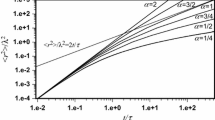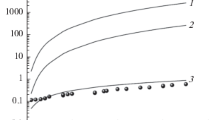Abstract
Analogs of the Lagrange equation for particles evolving in a space of fractal dimension are obtained. Two cases are considered: 1) when the space is formed by a set of material points (a so-called fractal continuum), and 2) when the space is a true fractal. In the latter case the fractional integrodifferential formalism is utilized, and a new principle for devising a fractal theory, viz., a generalized principle of least action, is proposed and used to obtain the corresponding Lagrange equation. The Lagrangians for a free particle and a closed system of interacting particles moving in a fractal continuum are derived.
Similar content being viewed by others
References
A. Z. Patashinskii and V. L. Pokrovskii, Fluctuation Theory of Phase Transitions, Pergamon Press, Oxford (1979) [Russian original, Nauka, Moscow (1982), 382 pp.].
Shang-Keng Ma, Modern Theory of Critical Phenomena, W. A. Benjamin, Reading, Mass. (1976) [Russian translation, Mir, Moscow (1980), 298 pp.].
S. G. Samko, A. A. Kilbas, and O. I. Marichev, Fractional Integrals and Derivatives: Theory and Applications, Gordon and Breach, Chur-Philadelphia (1993) [Russian original, Nauka i Tekhnika, Minsk (1987), 687 pp.].
A. E. Dubinov (ed.), Fractals in Applied Physics [in Russian], All-Russia Scientific-Research Institute of Experimental Physics, Arzamas-16 (1995), 216 pp.
A. I. Olemskoi and A. Ya. Flat, Usp. Fiz. Nauk 163(12), 1 (1993) [Phys. Usp. 36, 1087 (1993)].
L. Notale and I. Schnelder, J. Math. Phys. 25, 1296 (1994).
B. M. Smirnov, Physics of Fractal Clusters [in Russian], Nauka, Moscow (1991), 133 pp.
Ya. B. Zel’dovich and D. D. Sokolov, Usp. Fiz. Nauk 146, 493 (1985) [Sov. Phys. Usp. 28, 608 (1985)].
L. D. Landau and E. M. Lifshitz, Mechanics, 3rd ed., Pergamon Press, Oxford (1976) [Russian original, Nauka, Moscow (1988), 216 pp.].
H. Goldstein, Classical Mechanics, Addison-Wesley Press, Cambridge, Mass. (1950) [Russian trans., Nauka, Moscow (1975), 416 pp.].
T. Ando, A. B. Fowler, and F. Stern, “Electronic properties of twodimensional systems,” Rev. Mod. Phys. 54, 437–672 (1982) [Russian trans., Mir, Moscow (1985), 416 pp.].
I. P. Guk, in Material Science and Material Properties for Infrared Optoelectronics, 30 September–2 October 1966, Uzhgorod, Ukraine, SPIE, Bellingham, Washington (1996), p. 78.
Author information
Authors and Affiliations
Additional information
Zh. Tekh. Fiz. 68, 7–11 (February 1990)
Rights and permissions
About this article
Cite this article
Guk, I.P. Lagrange formalism for particles moving in a space of fractal dimension. Tech. Phys. 43, 353–357 (1998). https://doi.org/10.1134/1.1258985
Received:
Issue Date:
DOI: https://doi.org/10.1134/1.1258985




